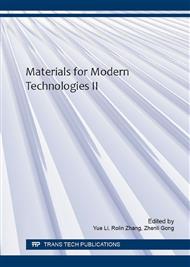[1]
A. Seeboth and D. Lötzsch, Thermochromic and Thermotropic Materials, Singapore: Pan Stanford Publishing, 2014, doi: 10. 4032/9789814411035.
Google Scholar
[2]
M.A. White and M. LeBlanc, Thermochromism in commercial products, J Chem Educ, 76 (1999), 1201–5, doi: 10. 1021/ed076p1201.
Google Scholar
[3]
A. Seeboth and D. Lötzsch, Thermochromic Phenomena in Polymers, Shawbury: Smithers Rapra, 2008, ISBN 9781847351128.
Google Scholar
[4]
A. Seeboth, A. Klukowska, R. Ruhmann, and D. Lötzsch, Thermochromic polymer materials, Chin J Polym Sci, 25(2007) 123–35, doi: 10. 1142/S0256767907001923.
Google Scholar
[5]
R. Kulčar et al., Dynamic Colour and Appearance of Thermochromic Offset Inks, in Proc. 5th International Symposium on Novelties in Graphics, Faculty of Natural Sciences and Engineering, Ljubljana, 2010, p.795–800, ISBN: 978-961-6045-79-7.
Google Scholar
[6]
R. Kulčar, M. Friškovec, N. Hauptman, A. Vesel, and M. Klanjšek Gunde, Colorimetric properties of reversible thermochromic printing inks, Dyes Pigm, 86 (2010) 271–7, doi: 10. 1016/j. dyepig. 2010. 01. 014.
DOI: 10.1016/j.dyepig.2010.01.014
Google Scholar
[7]
R. Kulčar, M. Friškovec, M. Klanjšek Gunde, and N. Knešaurek, Dynamic colorimetric properties of mixed thermochromic printing inks, Color Technol, 127 (2011) 411–7, doi: 10. 1111/j. 1478-4408. 2011. 00338. x.
DOI: 10.1111/j.1478-4408.2011.00338.x
Google Scholar
[8]
M. Friškovec, R. Kulčar, and M. Klanjšek Gunde, Light fastness and high-temperature stability of thermochromic printing inks, Color Technol, 129 (2013) 214–22, doi: 10. 1111/cote. 12020.
DOI: 10.1111/cote.12020
Google Scholar
[9]
M. Klanjšek Gunde et al., Functional properties of the leco dye-based thermochromic printing inksů, Proc. 63rd Annual Technical Conference Proceedings, Technical Association of the Graphic Arts, Pittsburgh, 2011, p.206–33.
Google Scholar
[10]
H. Tang, D.C. MacLaren, and M.A. White, New insights concerning the mechanism of reversible thermochromic mixtures, vCan J Chem, 88 (2010) 1063–70, doi: 10. 1139/V10-069.
DOI: 10.1139/v10-069
Google Scholar
[11]
O. Panák, N. Hauptman, M. Klanjšek Gunde, and M. Kaplanová, Colorimetric characterisation of thermochromic composites with different molar ratios of components, J Print Media Technol Res 1 (2012) 113–20, doi: 10. 14622/JPMTR-1204.
Google Scholar
[12]
O. Panák, M. Držková, and M. Kaplanová, Insight into the evaluation of colour changes of leuco dye based thermochromic systems as a function of temperature, Dyes Pigm, 120 (2015) 754–62, doi: 10. 1016/j. dyepig. 2015. 04. 022.
DOI: 10.1016/j.dyepig.2015.04.022
Google Scholar
[13]
M. Hajzeri, K. Bašnec, M. Bele, and M. Klanjšek Gunde, Influence of developer on structural, optical and thermal properties of a benzofluoran-based thermochromic composite, Dyes Pigm, 113 (2015) 279–87, doi: 10. 1016/j. dyepig. 2014. 10. 014.
DOI: 10.1016/j.dyepig.2014.10.014
Google Scholar
[14]
D. MacLaren and M.A. White, Design rules for reversible thermochromic mixtures, J Mater Sci, 40 (2005) 669–76, doi: 10. 1007/s10853-005-6305-x.
DOI: 10.1007/s10853-005-6305-x
Google Scholar
[15]
A.N. Bourque and M.A. White, Control of thermochromic behaviour in crystal violet lactone (CVL)/alkyl gallate/alcohol ternary mixtures, Canad J Chem, 93 (2015) 22–31, doi: 10. 1139/cjc-2014-0251.
DOI: 10.1139/cjc-2014-0251
Google Scholar
[16]
S. Burkinshaw, J. Griffiths, and A. Towns, Reversibly thermochromic systems based on pH-sensitive spirolactone-derived functional dyes, J Mater Chem, 8 (1998) 2677–83, doi: 10. 1039/a805994b.
DOI: 10.1039/a805994b
Google Scholar
[17]
J. Luthern and A. Peredes, Determination of the stoichiometry of a thermochromic color complex via Job's method, J Mater Sci Lett, 19 (2000) 185–8, doi: 10. 1023/A: 1006790104175.
Google Scholar
[18]
J. Luthern and A. Peredes, Determination of the stoichiometry of a thermochromic color complex via the method of continuous variation, J Mater Sci Lett, 22 (2003) 881–4, doi: 10. 1023/A: 1024410703372.
Google Scholar
[19]
Y. Ono and F. Katsuyuki, inventors. The Pilot Ink Co., Ltd, assignee. Thermochromic coloring color-memory composition and thermochromic coloring color-memory microcapsule pigment containing the same, US 7494537 B2, 2012 07/17.
Google Scholar
[20]
K. Tsutsui et al., inventors. Ricoh Company L, assignee, Method of reversible recording, EP 0 576 015 B1, (1998).
Google Scholar
[21]
C. Zhu and A. Wu, "Studies on the synthesis and thermochromic properties of crystal violet lactone and its reversible thermochromic complexes, Thermochim Acta, 425 (2005) 7–12, doi: 10. 1016/j. tca. 2003. 08. 001.
DOI: 10.1016/j.tca.2003.08.001
Google Scholar
[22]
A. Kondo, Microencapsulation utilizing in-liquid drying process (complex emulsion method), in Microcapsule Processing and Technology, J.W. van Valkenburg, ed., New York: Marcel Dekker Inc, 1979, ISBN 0-8247-6957-4.
Google Scholar
[23]
M. Palanikkumaran, K.K. Gupta, A.K. Agrawal, and M. Jassal, Highly Stable Hexamethylolmelamine Microcapsules Containing N-Octadecane Prepared by in Situ Encapsulation, J of Appl Polym Sci, 114 (2009) 2997–3002, doi: 10. 1002/app. 30923.
DOI: 10.1002/app.30923
Google Scholar
[24]
B. Alic, U. Sebenik, and M. Krajnc, Differential Scanning Calorimetric Examination of Melamine-Formaldehyde Microcapsules Containing Decane, J of Appl Polym Sci, 119 (2011) 3687–95, doi: 10. 1002/app. 33077.
DOI: 10.1002/app.33077
Google Scholar
[25]
B. Boh, E. Knez, and M. Staresinic, Microencapsulation of Higher Hydrocarbon Phase Change Materials by in Situ Polymerization, J of Microencapsul, 22 (2005) 715–35, doi: 10. 1080/02652040500162139.
DOI: 10.1080/02652040500162139
Google Scholar
[26]
I. Krupa et al., Phase Change Materials Based on High-Density Polyethylene Filled with Microencapsulated Paraffin Wax, Energy Convers and Manag, 87(2014) 400–9; doi: 0. 1016/j. enconman. 2014. 06. 061.
DOI: 10.1016/j.enconman.2014.06.061
Google Scholar
[27]
B. Sumiga et al., Production of Melamine-Formaldehyde PCM Microcapsules with Ammonia Scavenger used for Residual Formaldehyde Reduction, Acta Chim Slov; 58(2011) 14–25; ISSN 1318-0207.
Google Scholar
[28]
J. Karpiuk, Dual Fluorescence from Two Polar Excited States in One Molecule. Structurally Additive Photophysics of Crystal Violet Lactone, J of Phys Chem A, 108 (2004) 11183–95, doi: 10. 1021/jp0474935.
DOI: 10.1021/jp0474935
Google Scholar


